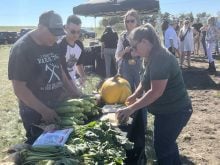Gen Thomson calls his industry the original recycler.
Thomson, who runs Harvest Salvage in Brandon, said the industry finds a new life for agricultural cast-offs.![]()
It is used by farmers and equipment dealers who need an inexpensive source of parts as well as suppliers of obsolete and hard-to-find pieces.
After the salvage companies are done removing useful parts, the leftover steel is loaded, weighed and hauled to steel plants, where it becomes a cost competitive source of raw materials for pipes and parts.
Read Also

Canada’s plant hardiness zones receive update
The latest update to Canada’s plant hardiness zones and plant hardiness maps was released this summer.
The Saskatchewan Waste Reduction Council says 65 percent of Canadian steel is recycled. Every tonne that is recycled saves 1,000 kilograms of iron ore, 560 kg of coal and 48 kg of limestone.
Joe Henry of Watrous Salvage in Watrous, Sask., said one-third of a farm implement that ends up in a salvage yards is resold to the agriculture business, and the remainder is recycled.
Charlie Smith of Combine World in Elstow, Sask., said the agricultural wrecking industry is no longer seen as the junkyard business.
“The smaller operators and those who don’t make use of every pound of material and find new products and services to sell have left this business.”
Smith said it is a highly sophisticated sector of agriculture.
“There’s no room for junk.”














